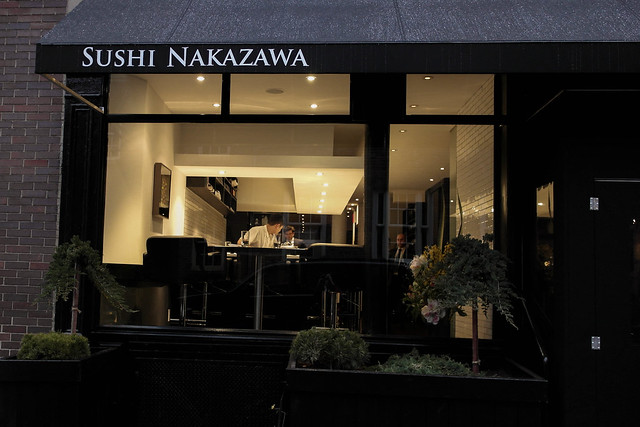
We planned the dinner as precisely as we could (i.e., 30 days in advance) via OpenTable. Tables are released nightly at 12:01 AM for both the sushi bar and the dining room. As these reservations get snatched up quite quickly, I recommend logging into OpenTable about fifteen minutes before, preparing all the desired reservation settings ahead of time so all you have to do is press "Find a Table" at midnight. All the advice I can offer aside from this is to be quick and DO NOT hesitate. If you can, the dining experience at the sushi bar is -- hands down -- the way to go. Interacting directly across from Chef Nakazawa and his team is so much fun and also makes for notable dining theatre. Please note, though, there are only ten seats at the sushi bar, and the restaurant does three seatings per evening.
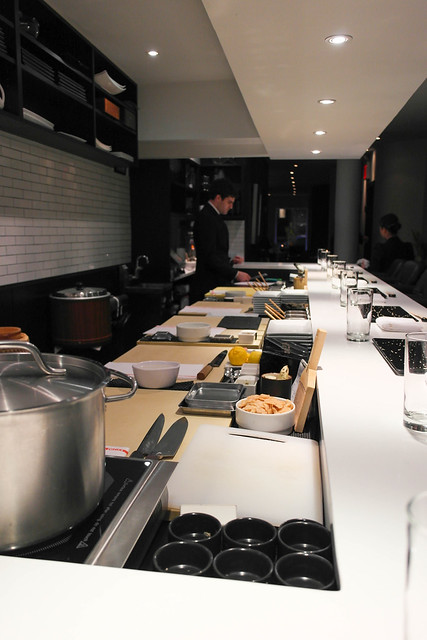
The décor of Sushi Nakazawa's sushi bar is simple and minimalist -- a greyscale combination of a white countertop, a black speckled marble platter for sushi presentation, and the remaining fixtures a tasteful mix of blacks, greys, and whites.
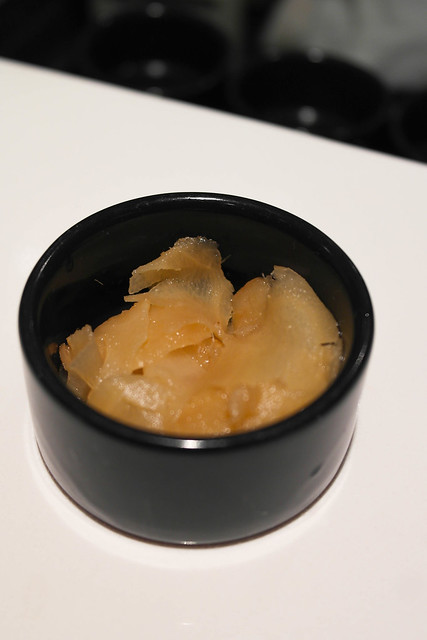
Each diner gets his/her own ramekin of fresh housemade ginger. Very biting and refreshing!
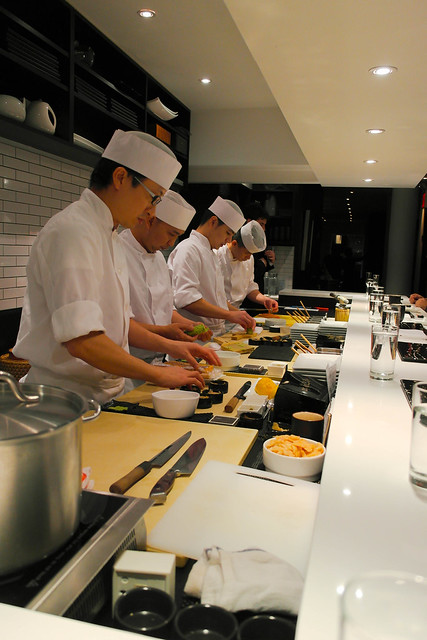
Shortly after we were seated, the sushi chefs made their way to their stations and speedily began preparing for the omakase ahead.
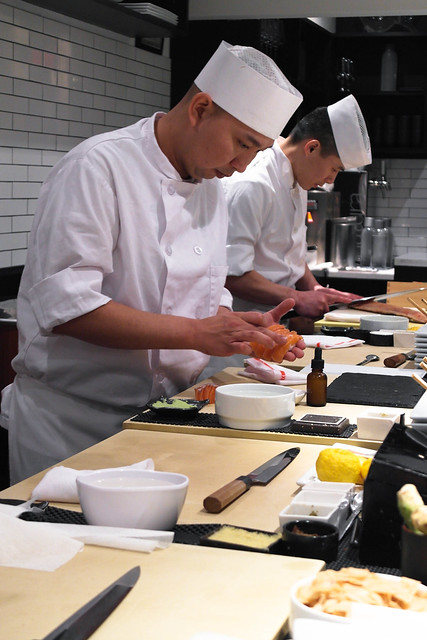
Chef Nakazawa got things started quickly, preparing the first pieces of sushi for us.
Sushi Nakazawa "proudly serves one of the most in-depth sake collections in NYC with a focus on each element of the omakase menu." Sommelier Rick Zouad has curated this list, "focusing on all prefectures of Japan featuring some of the most elite sakes and best microbrews available." Along with by-the-glass options, the restaurant also offers two sake pairings with the omakase: a basic pairing of five different sakes for $40, and the premium pairing of seven different sakes for $80.
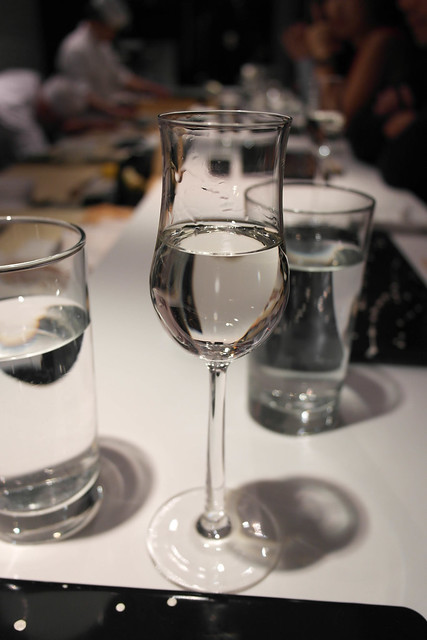
The first sake was Joto Junmai (if I recall correctly), which was to be paired with the first two pieces of sushi, both of which were from the salmon family. The sake had a very fruity taste to it (mainly pear fruit) and was slightly chilled.
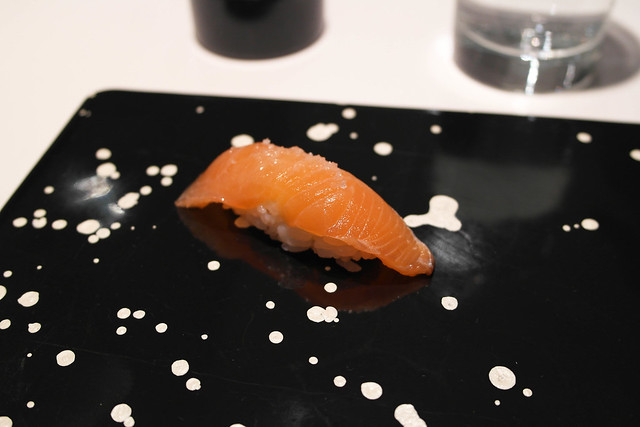
The first piece of the omakase was cherry salmon from Hokkaido with a sprinkling of sea salt. It was a bit meaty, but not in the traditionally expected way, making it the perfect first nosh. It went beautifully with the sake, as the temperature of the fish and sake blended very nicely to enhance each other's flavors.
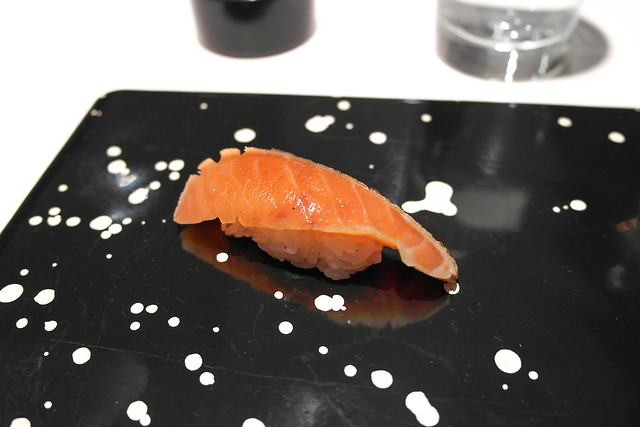
Next up was the hay-smoked chum salmon from Hokkaido. It had that texture of cured salmon (it was smoked, after all) as well as a gorgeous smoky flavor to it. The ridges of the salmon made for a nice bite, and this also went really well with the sake -- the smokiness really brought out even more from the sake.
The second sake was Kaori Junmai Ginjo, which was lighter and less aggressive than the last sake. With touch of white pepper on the palate, this sake was to be enjoyed with the next five pieces.
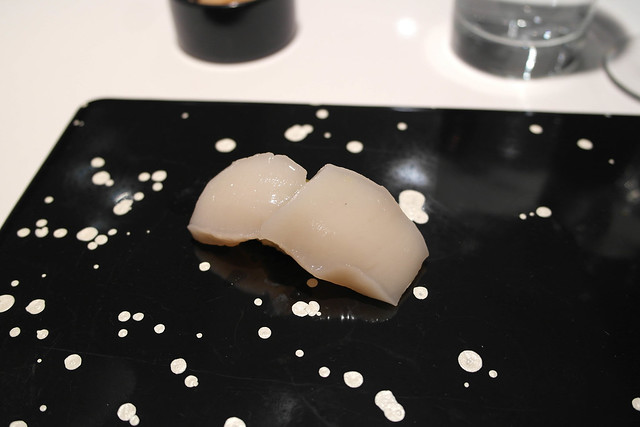
This was hotate (scallop) with yuzu peper and a sake sauce from Maine. This piece was very memorable in that it was still live when Chef Nakazawa served it to us -- he even asked us to give it a little poke to see that it could still move. While that may have seemed unsettling to the timid of diners, I was unbelievably excited to try live hotate for the first time. It was peppery and tiley -- a texture that was less "blobby" than most scallops I've had previously. Having it served live truly does make a difference. The hints of white pepper from the Kaori sake played well against the yuzu pepper in the scallop.

This next piece was mirugai ("giant clam" or geoduck) from Washington state. Lightly torched, the mirugai was thinly sliced and had a delightfully snappy texture to it. Mirugai is always a treat for me, and this ocassion at Nakazawa was even more so. The barely blackened exterior from the blowtorch gave it that extra dimension of je ne sais quoi that sets this apart from your typical mirugai sushi experience, plus the hint of white pepper from the Kaori sake complemented this flavor profile well.

The following piece was a variety of fish that I've never heard of before (and thus, have never had either) -- silver pomfret from Japan with black pepper flakes. It was a combination of light and savory with a denser punch from the black pepper flakes and the Kaori sake.
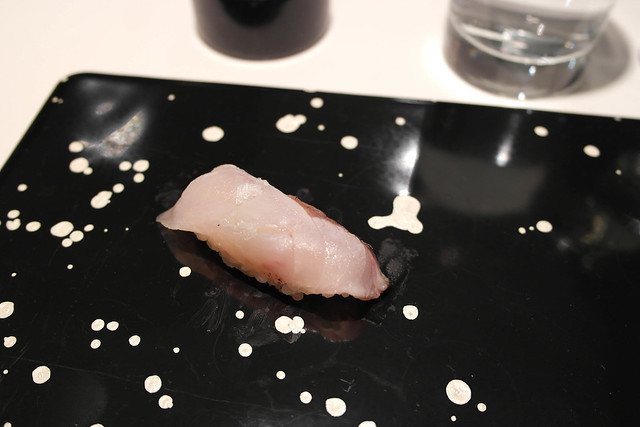
Another variety I got to try for the first time was the black gnomefish with lemon seasoning. It was a really fun combination of crackly, smoky, and zesty -- another solid complement with the Kaori. Definitely one of my favorites in the omakase.
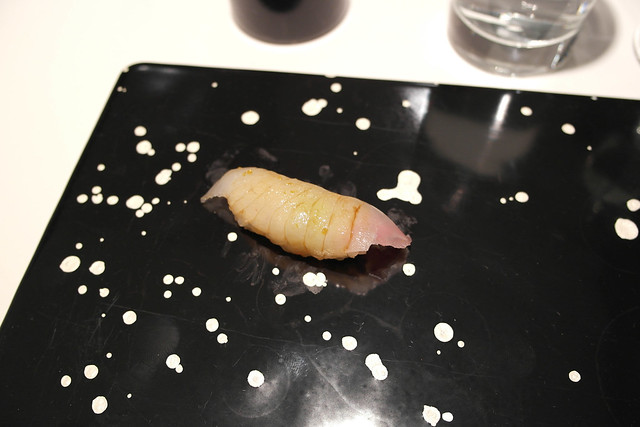
The last piece paired with the Kaori was the hirame (fluke) with yuzu. The yuzu added some pretty citrus notes, making a solid piece of fluke. Hirame isn't necessarily my favorite when it comes to sushi, but it was probably the best prepartion of fluke that I've ever had.
The third sake in the pairing was the Kurosawa Junmai Kimoto for the next five pieces. This sake is meant to be more granular and velvety than the previous sakes to take on the oiliness of the next pieces of fish (especially with the shellfish) and really bring out the latent umami flavors.
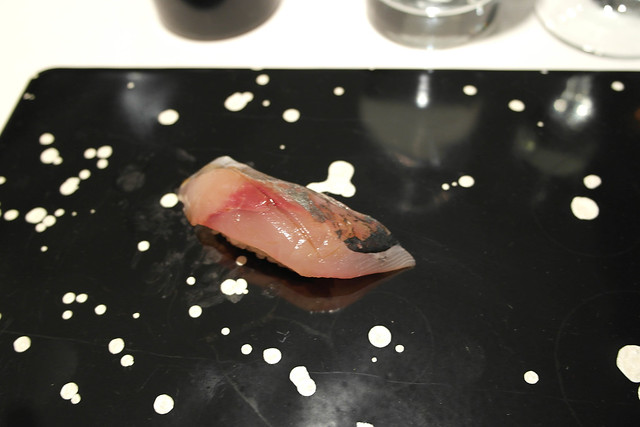
The first mackerel in Chef Nakazawa's omakase was the aji (horse mackerel) with ginger. You know mackerel is prepared to perfection and really damn good when it doesn't taste like mackerel. Yeah, yeah -- it definitely sounds like a senseless tautology, but it's totally, 100% true. When it doesn't taste any bit fishy, you know the sushi chef really knows his stuff -- and Chef Nakazawa really, really knows his stuff. The aji was a nice introduction to the coming flight of mackerel, as it had just a touch of oiliness, and was a stellar pairing with the Kurosawa Junmai (which cut right through the oils and enhanced its umami experience).

The second mackerel was konoshiro (gizzard shad), which had a more intense oiliness to it compared to the aji. It was very wise to serve the mackerel pieces in a progressive order, from light to heavy, this way the sushi bar patrons can gradually sink their teeth into this bold family of fish. Mackerel isn't necessarily a variety of fish that I crave (like uni, hamachi, or salmon), but I do appreciate it when it is showcased in a beautiful way like it was here to show the contrasting repertoires of fish in the world of sushi. Since the konoshiro was heavier than the aji, it went even better with the sake pairing.
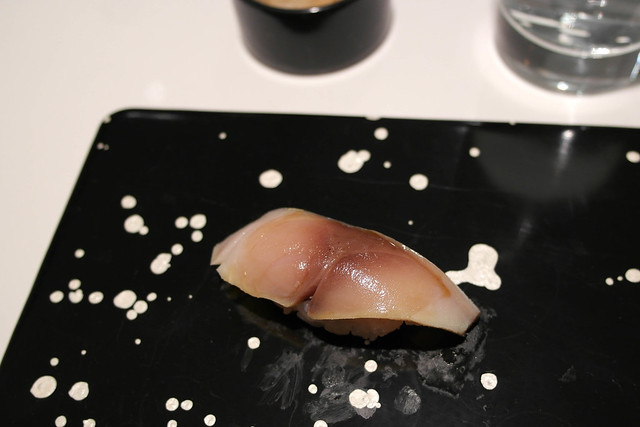
The last of the mackerel was the kohada (mackerel) from Fuji, Japan that had been pickled and aged for seven days. The kohada had a smoother and tamed oiliness to it than the preceding pieces, most likely as a direct result from its aging process. The mackerel is no doubt something to ooh and ahh about at Sushi Nakazawa.
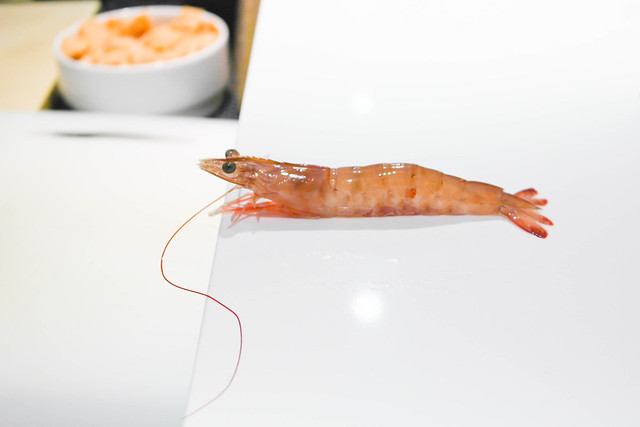
This next piece was a pretty lively one -- quite literally, too. Chef Nakzawa placed ama-ebi (tiger shrimp) from Florida on the counter, and instantly, it started to move and jump around a little. It was still alive!
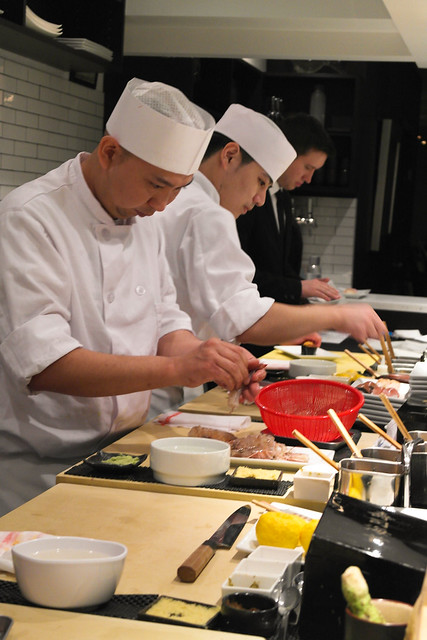
After that brief show of dancing ama-ebi, Chef Nakazawa bid farewell to the shrimp with a simple, tongue-in-cheek "Sayonara, Shrimp!" and quickly snapped its head to prep to serve it as pretty much live sushi.
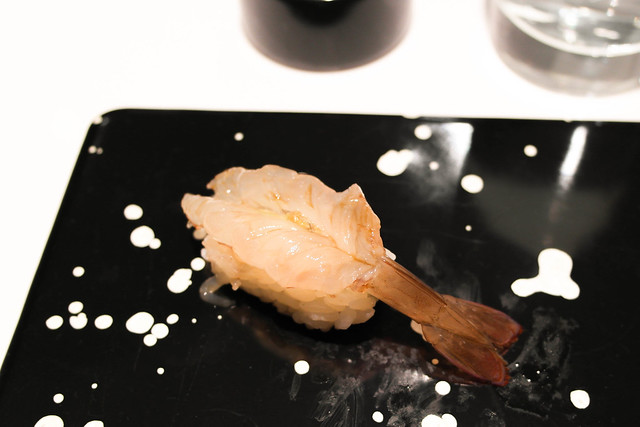
Here it came -- the ama-ebi served (pretty much) live. Before, I had had my fair share of sweet shrimp and ebi, but never had I experienced it served that fresh. It is worth noting that the shrimp indeed tasted sweeter than any raw shrimp I had enjoyed previously. Filed away as one of the most surreal eating experiences, eating live ama-ebi was such a thrill (perhaps it was just knowing that the ama-ebi was just alive seconds before serving). Either way, doesn't matter -- it was crazy good, end of story.
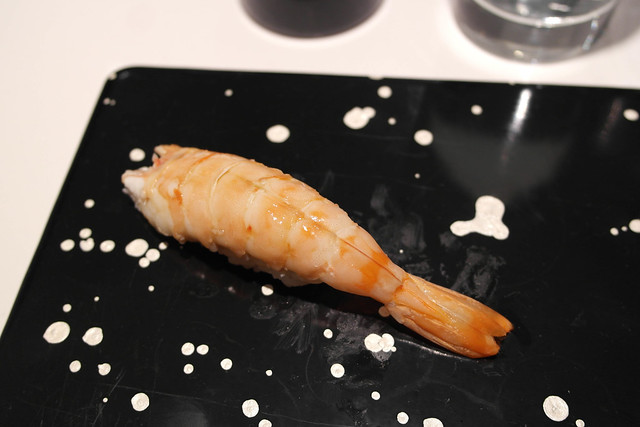
To follow the ama-ebi was just kurumaebi (tiger prawn) of the Madagascar rouge variety. This was prepared similarly to the ama-ebi, only with a couple extra steps. During the first half of the omakase before the ebi, I watched the apprentice sushi chefs preparing the kurumaebi in a manner both precise and seamless for the dining room patrons in true Jiro Ono style -- the prawns are killed merely minutes before (just like the ama-ebi) and immediately flash-boiled. I also just found out from reading A Life Worth Eating's review of Sukiyabashi Jiro that the kurumaebi "is sliced in such a way that the flavor and juices of the head are incorporated with the meat, and so the head itself is not necessary." The result was tiger prawn exquisitely cooked to perfection. It had that magical texture, balancing between barely touched and lightly cooked (descriptors inspired by Chef Eric Ripert), with none of that unfavorable mealiness you get sometimes with shrimp. One of the most impressive dishes that evening (though to be fair, I was really impressed with nearly everything), a true testament to the care and discipline that goes into the art of sushi making at Sushi Nakazawa.
The fourth sake pairing was Seikyo Omachi Namazake which was to be paired with the next five pieces of sushi. This sake has a hint of clove flavor and was selected to be enjoyed with meatier fish as it has more structure to cut through these fattier and more savory cuts.
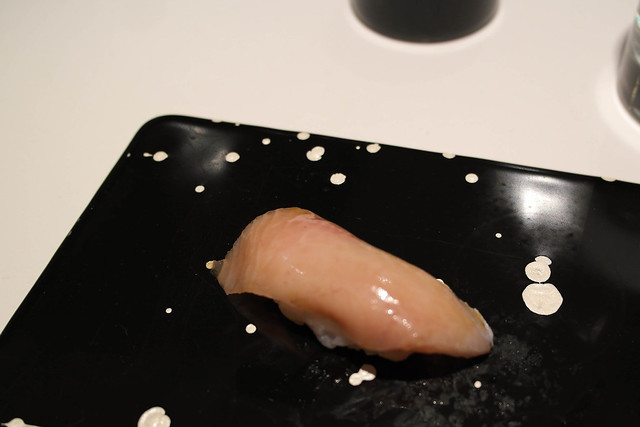
The first of the fattier sorts of fish was hamachi (wild yellowtail). It had a delightful marbledness to its texture, one that melted the same way as toro (fatty tuna) would, which is something I haven't really experienced with hamachi so that was a really fun surprise. I loved this piece so much that I ordered it once more at the end of the omakase.
My camera decided to stop working at the most inopportune time, when Chef Nakazawa served hay-smoked bonito from Japan (you can find a shot of it here from Time Out New York's review). The bonito had a peppery-ginger flavor to it along with its light smokiness where the texture was part structured, and part savory (i.e., melty). Many dimensions of umami here, making it one of the most delicious pieces in the omakase.

Just as he did with the mackerel, Chef Nakazawa began the next flight of tuna with the leanest of cuts -- akami (lean bluefin tuna) from Boston. I typically find akami to be bland in taste/flavor and boring in texture -- there usually isn't much going on. However, the bona fide sushi chef knows exactly how to coax the hidden flavors from this lean cut of tuna, and Chef Nakazawa is truly an honest-to-goodness wizard of these sorts. While the akami here was very meaty, it also had a soft tenderness to it -- pretty close to the kind of tenderness experienced with the fattier cuts of chu-toro and o-toro, without marbleization to help bring that out (meaning it all comes from the preparation of the fish alone). If the akami at Sushi Nakazawa doesn't turn the tuna skeptic onto Team Tuna, then for him/her it will forever be a lost cause.
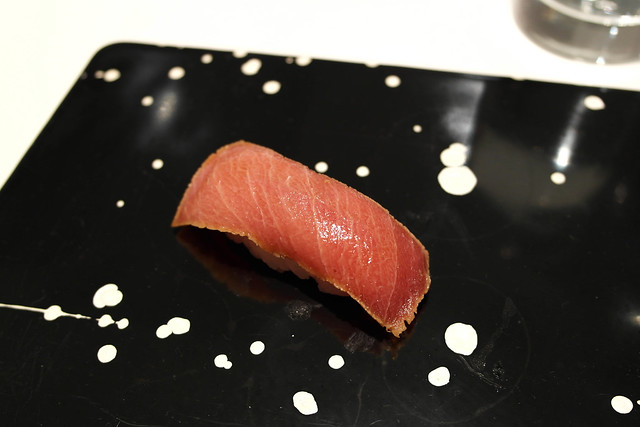
Next came chu-toro (medium fatty tuna) marinated in soy sauce, which you can tell from just looking at it that it was going to be amazingly good. I didn't pass up a chance for an encore of this. Chef Nakazawa hit that culinary sweet spot with just the right amount of soy marinade, tucked sweetly in the small crevices of tuna fat.

And the epitome of all that is good in the world of sushi, here was served o-toro (fatty bluefin tuna) with a marbledness that glistened with the most captivating luster. Quite (well, almost) literally the sopressata of the sea, kindred spirits in appearance and fattiness, the o-toro was a divine spectacle to witness firsthand. It not only had that rich, melty quality to it (as you would expect in the fattiest of tunas), but it also boasted a refined texture, one that is deliberate and precise for the purpose of bringing the ultimate mouthwatering rumination.
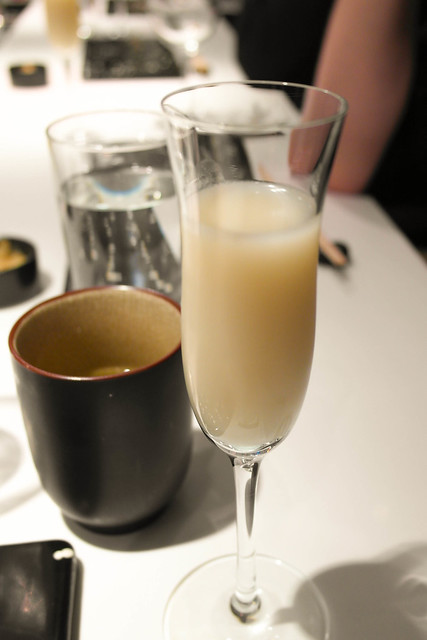
The last sake pairing was one that had to be photographed because of its unique opaque quality. This sake, Murai Family Nigori Genshu, is just as interesting as it appears as it emphasizes the umami flavors and textures of the remaining four pieces of sushi in the omakase. It has subtle hints of coconut and boasts a sweet, creamy finish. Probably my favorite sake from the entire flight of five -- need to track this down and get a few bottles to enjoy at home!
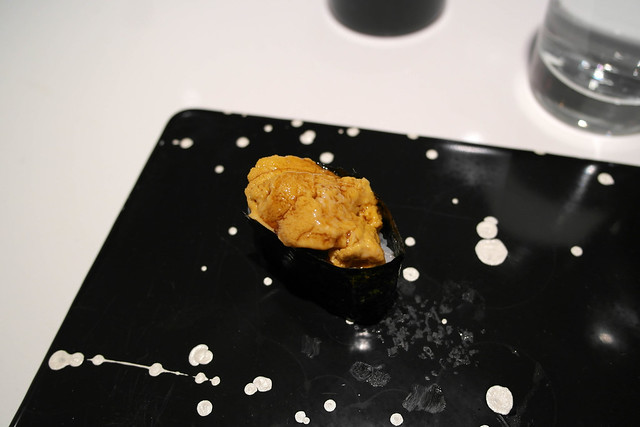
First to be paired with the Murai Nigori Genshu was the uni (sea urchin roe) from California. Uni from California consistently has that subtle brine to it along with a rich, buttery texture, which I always look forward to when I have an evening out to take in New York City's sophisticated sushi scene. You would imagine my surprise when I encountered a twist to my regular favorite -- the sake pairing brought forth a tropical element that was both playful and unexpected. The quality of the uni is simply exquisite, right in line with the quality establishment that is Sushi Nakazawa. Can't imagine what live uni would taste like here if regular uni is like this!
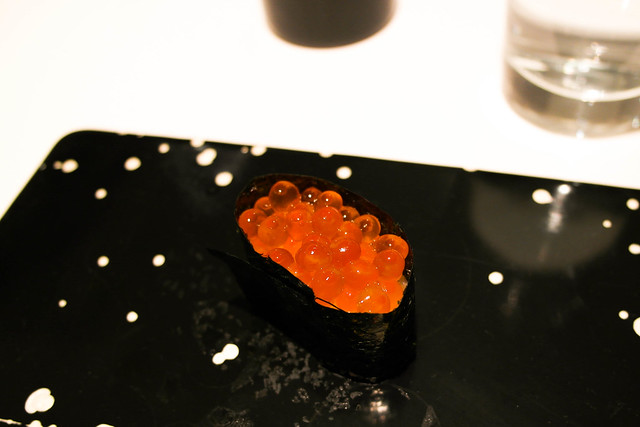
After the uni wasthe soy-marinated chum ikura (chum salmon roe), surrounded by the perfect strip of nori, one that was well-toasted with a quiet, delicate crunch. These briny orbs bursted right into the warm rice for the wonderful combination of salty and richness. Really well done!

The last fish of the omakase was the anago (sea eel), and it was the best anago that I've ever had. It was just the right amount of kabayaki glazed on top (a very light coating) and had a sweet toastedness to it. It was a very lean cut of the eel, which really brought out the true flavors of it without any distractions of the overly fatty and oily ones you see regularly.
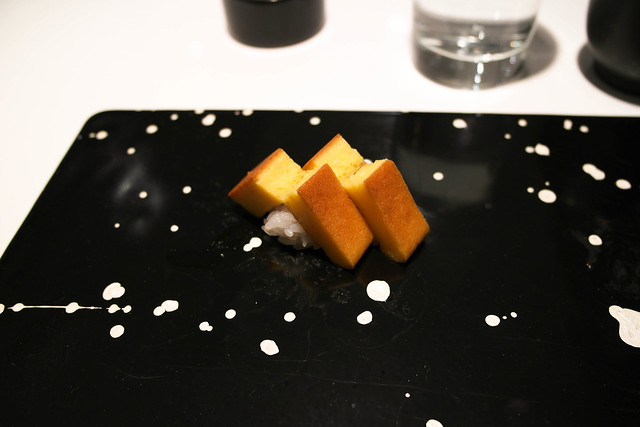
Last but not least was the famed tamago (sweet, fluffy egg custard) -- the recipe that Chef Nakzawa had made over 200 times before he finally received a nod from Chef Ono during his time at Sukiyabashi Jiro. This tamago was unlike anything I had ever tasted before. It wasn't at all like the steamed egg deal that you would usually find in your everyday sushi joint. It was more of a dessert in sushi form, one that had a brilliant dichotomy of sweet and savory, dancing between a fluffy sponge cake and a dense pound cake -- incredible culinary ingenuity at work, for sure! What's also interesting is that Chef Nakazawa is deeply meticulous in that he "cuts the tamago in two pieces forwomen so bites aren't as cumbersome." It was truly surreal to try Chef Nakazawa's signature dish firsthand -- to witness the result from disciplined perseverance to achieve the ultimate version of something. You won't truly understand what I'm talking about here until you try the tamago for yourself!
After the tamago, Chef Nakazawa asked the ten patrons at the sushi bar if there was anything else they wanted. Marcus and I couldn't resist having another piece of chu-toro to savor. I also had another hamachi, while Marcus had another hay-smoked salmon.
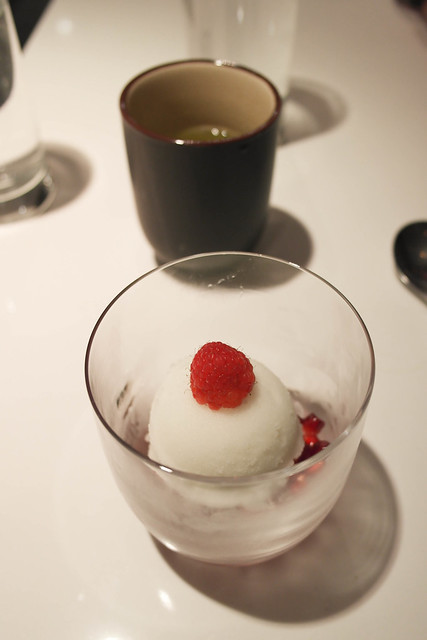
Before the official end of the meal, we were served some green tea and a palate cleanser -- yuzu sorbet with pomegranate and raspberry. Tangy and citrusy, the sorbet ended our meal in a pleasant and refreshing way.
Findings: I am happy to report that hype surrounding Sushi Nakazawa is not one of myth or disappointment -- instead, it is everything you would imagine it would be and more. A dining experience here is both relaxed and magical. You get to hang out for an evening with a chef who is not only unbelievably talented but one who is adorably entertaining and has a contagiously upbeat spirit. Watching him work his wizardry on gorgeous varieties of fish is such a treat -- his muscle memory in sushi-making brings out the best and brightest flavors is simply astounding, especially his "Goldilocks balance" with just the right touch of wasabi in between the fish and rice.
Unlike many of the upscale sushi bars in this city, the ambiance at Chef Daisuke Nakazawa's eponymous restaurant is relaxed and comfortable with modern Zen touches abound. In fact, the dining style is what Chef Nakazawa refers to his style as New York-mae -- "not quite as traditional as his training in Japan, but it’s not entirely Americanized either." If this is what the future of New York City sushi looks like, then I definitely want to stay on board. I've had the pleasure of visiting many of the city's top places (including Sushi Yasuda, Sushi Dojo, Ichimura at Brushstroke, Sushi Azabu, Jewel Bako, Sushi of Gari, and 15 East), and while most are pretty damn good, they pale in comparison to the birthday dinner I had at Sushi Nakazawa, which was bar none the best sushi dining experience I've ever had (though, if I had to pit another place to be close to this, it'd be Ichimura). So if you have a chance to come here, there's no need to think about it -- please do!
A big thank you to Marcus for such an unforgettable birthday dinner -- love you! :)
Price point: $150 for a 20-course chef's omakase, $40 for sake pairing of 5 varieties.
--February 21, 2014
Sushi Nakazawa
23 Commerce Street
New York, NY 10014
http://www.sushinakazawa.com

No comments:
Post a Comment